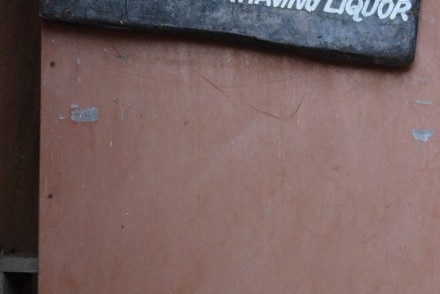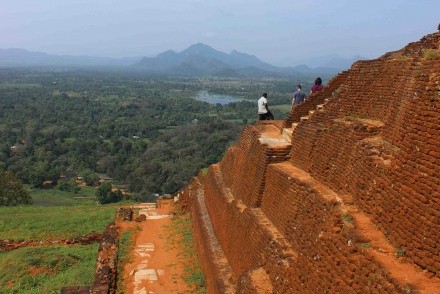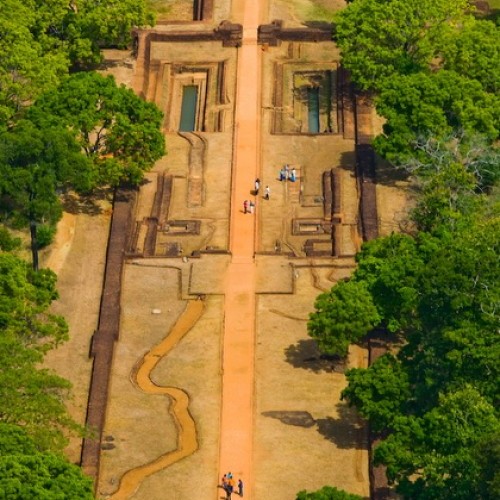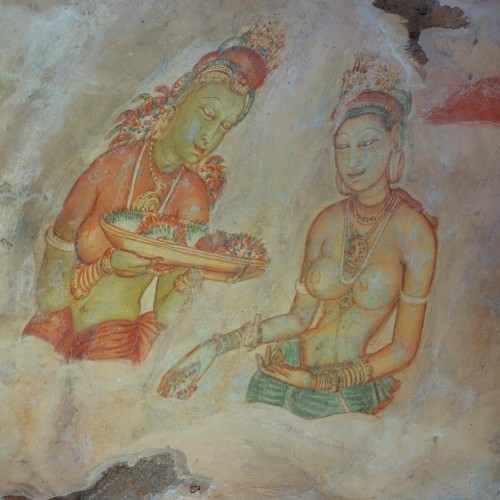Sigiriya: Site Details
Lion Rock
The principal areas of Sigiriya are:
- Fresco Gallery
- Mirror Wall
- Lion's Platform
- The Palace on the Summit
- The Gardens of Sigiriya

Fresco Gallery
Sensuous Celestial Nymphs
Fascinating amongst the pictorial art of Sigiriya are the glamorously sensuous paintings of feminine beauty. This was a daring endeavour by Kassapa, since Sri Lankan art was solely inspired by Buddhism at that time, a religion that preaches the cessation of lust to achieve everlasting happiness.
Of the original 500 or so frescoes, which vie with those in Ajanta in western India, only 21 remain. They are remarkably well preserved, as they are protected from the elements in a niche in the rock wall. In the style of Ajanta, the first drawing was done on wet plaster and then painted with red, yellow, green and black. Slightly smaller than life-size, they are seen in three-quarter profile. Their beauty can be best enjoyed when you examine the frescoes in detail, since there is a striking diversity in mood and personality, face and body, clothes and make up.
What were the real reasons for these paintings at Sigiriya? Whilst some have portrayed these figures as ladies in Kassapa's royal court in a devotional procession to the nearby shrine at Pidurangala, or representations of clouds and lightning moving about the peak of Mount Kailasa, the current consensus is that the figures are "portraits" of apsaras (celestial nymphs) and attendants above clouds - offering flowers, scattering petals or bathing - in keeping with south Indian traditions.

Mirror Wall
Ancient Graffiti
On the way to the Lion's Platform and beneath the gallery containing the frescoes is the Mirror Wall. This highly polished plaster wall, believed to have been coated with polished lime, egg white and honey, still has a reflective sheen, but only in a few areas not damaged by ancient graffiti.
Scribbled on the surface of the Mirror Wall are nearly 1500 pieces of prose or poetry composed by the ancient visitors who flocked to Sigiriya from all over the island. These poems, which testify to the sightseers' appreciation of art and beauty, were mostly written between the 7th and 11th Centuries and are said to be Sri Lanka's oldest graffiti. Most of the graffiti is written in Sinhalese, but some of the poems are written in Sanskrit and Tamil.

Lion’s Platform
Lion's Paws and Stairway to the Summit
Sigiriya rock fortress has a half-way stage at its northern end, where a large plateau offers rest and stalls selling refreshments.
The two enormous lion's paws are all that remains of the giant beast that gave the rock its name, for, incredible though it may seem, the entire rock was transformed into a mountainous lion by the addition of brick-built foreparts, stuccoed and presumably painted. There were originally steps leading between the paws and into the lion's mouth. The sheer audacity of the idea is breathtaking and the surviving paws themselves are of a scale to make you shudder. They are expressively moulded and intimidating in size. By building this sculpture Kassapa was certainly trying to intimidate his enemies, but at the same time he was also claiming his kingship over the "lion race" - the Sinhalese.

The Palace on the Summit
A Usurper's Pleasure Palace
Emerging from the jaws of the regal lion, now destroyed by the torrential downpours and gusty winds it has suffered over 15 centuries, you climb a staircase clinging to the side of the Lion Rock and arrive at the summit and the ruins of the palace.
A unique palace, with layout and ground plan clearly visible, it is strikingly different to those found in Anuradhapura and Polonnaruwa. Whilst the inner palace occupies the lower eastern sections, and the palace gardens cover the south, they all converge on a large and lovely rock-cut pool, probably used for water storage. There would have been the granite throne, dancing terraces, a small pool fed by rain water, drinking water tanks, sleeping quarters for the concubines, a small flower garden and precariously positioned platforms for guards.
There are still the foundations to the king's audience chamber and his anteroom. Once again, there is a huge throne in a semicircle where his advisors would sit - justice was swift and often brutal. Immediately below the audience chamber was another granite slab, which was the place of execution. Much of the construction is in brick, faced with lime plaster but there are sections built with limestone slabs which would have been carried up. The upper structures which have disappeared were probably wooden.
With thousands of marbled steps and walkways, this 1.2-hectare site is simply stunning and the panoramic views breathtaking.

The Gardens of Sigiriya
Water, Boulder and Terraced Gardens
The Gardens of Sigiriya are a unique achievement, not only because of their complex hydraulics, but also because they are so well preserved, their antiquity preceded only by the ancient gardens of the Romans such as the gardens of Pompeii and Herculaneum, and the imperial gardens of Hadrian at Tivoli. The Water Gardens, Boulder Gardens and Terraced Gardens make a harmonious picture on a grand scale.
Water Gardens
The Water Gardens, which are still well preserved, are a combination of the Hanging Gardens of Babylon, the boulder gardens of China or Japan, and the water gardens of ancient Rome. The Terraced Gardens flow down to the Boulder Gardens and then to the geometrically laid out Water Gardens in the western precinct. With running water and fountains, pools and ponds, aquatic flowers and birds with gorgeous plumage, tropical trees with bright blossoms, these royal gardens remain a place of serenity for mind and body.
The entire Water Gardens are in a walled enclosure. With winding waterways, shallow reflecting pools, corbelled water courses, and marbled floors, and an intricate layout of tiled buildings, these gardens are an ideal location to get a glimpse of the splendour of Sigiriya.
Four L-shaped water pools near the entrance to the gardens were almost certainly used as bathing pools, since they have polished walls, flights of steps and surrounding terraces. Reinforcing the symmetrical layout, towards the Lion Rock, are four large islands surrounded by moats located either side of the walkway. "Cool Water Palaces" once occupied the two inner islands.
Abutting these islands are fountains fed by waters from the artificial Sigiriya Lake under gravitational pressure. Using symmetrically perforated limestone plates to fashion their spouts, these fountains operate in rainy weather even today. Another remarkable pool, octagonal in shape, is hidden from the main western walkway, and adds further amazement. Surrounded by a wide terrace following its shape, the pool is sheltered by a gigantic boulder almost six-storeys high, a bold arrangement of water harmonising rock, with the pond located at the very point of transition from the Water Gardens to the Boulder Gardens.
Boulder Gardens
The Boulder Gardens are in sharp contrast with the geometrical symmetry of the bordering water gardens, yet the fusion of the two gardens is remarkable. With similarities to the boulder gardens of China and Japan, picturesque boulders of varying size grace this area. Linked together by winding passages, with boulder arches and limestone stairways, edifices of little known character stood on almost every boulder, whilst there were rock caves beneath them. The intriguing honeycombed holes on these boulders are nothing more than footings for brick and timber buildings.
Audience Hall Rock and Cistern Rock
Equally fascinating are the rock carvings on the boulders, especially those on an enormous split boulder. On the fallen half, known as the Audience Hall Rock, is a 5-metre long carved stone throne facing a levelled square. On the standing half is a water reservoir, dug into the rock, hence its name, the Cistern Rock.
Cobra Hood Cave
Another boulder of interest is the picturesque Cobra Hood Cave, so named because of its shape. Buddhist monks from as early as the 3rd Century BC used this cave, though its painted ceiling has been dated to the period of Kassapa (5th Century AD), who founded the rock fortress and surrounding gardens.
Preaching Rock
Preaching Rock, located on the side of the octagonal pond, is also impressive. Its tiered platforms are believed to have been used by orating monks. Clearly, the Boulder Gardens, with its many caves, had been used as a monastery long before Kassapa incorporated it into his royal pleasure gardens.
Terraced Gardens
Merging with the Boulder Gardens are the Terraced Gardens, with each terrace rising above the other, similar to the Hanging Gardens of Babylon. Tumbledown walls now retain the mounting earth. Impressive brick-built staircases with limestone steps traverse the terraces, providing access to the uppermost terrace and onwards to the Sigiriya Rock itself. The once magnificent Sigiriya Wewa could also be reached from here. This lake is the main source of water for the gardens and, as seen today, it is only a fraction of its original size.
It is difficult to imagine the maze of pipe work buried beneath your feet. This intricate network covering the entire Sigiriya complex, with control valves, ring mains, manholes, silt traps, by-pass conduits and the like, is comparable to modern networks. Stone drains encased in clay carried water horizontally, and down-pipes, made of two stone semi-circular sections held together by metal straps, carried water vertically. You will also see many open channels cut into the rock itself used for collecting water drained from the summit. Excess water overflowed to irrigate the lower areas of Sigiriya. Conservation was paramount in the minds of the designers of Sigiriya.











